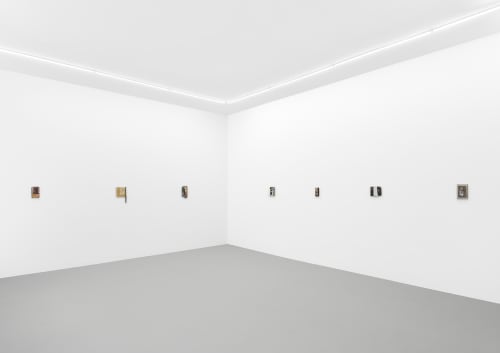In March 2020, Mary Ramsden (b. 1984, based in London) began a new series of abstract portraits. These were motivated by the impressions of the first lockdown in the context of the Corona Pandemic. The lack of proximity to the people around her and the only ‘fragmentary’ communication via video calls made her want to ‘spend time’ with them, if not in person, then in a figurative sense.
Ramsden took inspiration from the icon-painting of those cult and holy images that played an essential role in worshiping saints in Byzantine art. The artist is primarily interested in the concept of ‘visualization’ as it has characterized the cultural history of humankind since its beginnings. Here, the lack of reality, for example through the absence (of a person) is understood as a detachment, which is attempted to compensate with the help of (pictorial) visualization.
Mary Ramsden now takes up this idea to counteract the Corona-imposed sense of being alone or thrown back on oneself. The unusual thing about it is that the portraits are not — as one might think hearing the term portrait — figurative, pictorial representations of people, but small-format, abstract compositions, amalgams of painting, material collages, and portraits in the metaphorical sense.
Almost all of the works shown in the exhibition “Blunt Instrument” consist of several overlapping material layers. These are mostly wooden panels painted, sawn, broken with dots of color, painted over the entire surface, or partially. She combines these with other common household materials such as plastic, corrugated cardboard, mirrors, pieces of metal, leather and more.
The painterly accents here are very manifold. Sometimes Ramsden paints the material entirely, occasionally only in parts, sometimes before the materials are joined together, sometimes afterward. The entire range of painterly techniques can be found, from thick, pasty, almost dry application of paint to full-area overpainting to thin, glazed ductus. The layers of material prepared in this way are then given other painterly accents. Gestural markings, graphic lines, pictographic forms, or brushstrokes that seem frozen in time are added. Not infrequently, the wood is additionally splintered, drilled, or has irregular edges.
For all the variety of different formal and material choices, what they all have in common is a somnambulistic certainty in the painterly settings and the tactile presence of the materiality and surfaces.
Although she sees this series as portraits, Mary Ramsden does not see herself as a portrait painter. “I wanted to play about with notions of traditional portraiture and employ assembled wall-based constructions as a means to locate a sense of how a person I know or have known is, to me.” (Ramsden)
In a time characterized by glossy screen surfaces on which we constantly tap, swipe, and pinch, the sometimes crude materiality of Mary Ramsden’s works, their haptic sensoriality, and the bold gestures of her painterly settings are soothing oases that invite contemplation about color, form, material, and painting.
In October, the book Blunt Instrument (Book works) will be published with works from the series of the same name and texts by authors with whom the artist was in lively exchange during the creation of the series of works.

